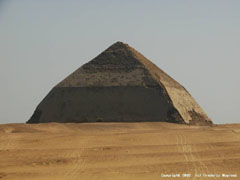Dashur : pyramids
On the site of Dahshur, two large pyramids rise : the rhomboidal pyramid of Sneferu (the father of Khufu) and the red pyramid of same Sneferu.
The rhomboidal pyramid of Sneferu
 The rhomboidal pyramid of Sneferu is the largest of the site, known as double slope pyramid, the second was built by Sneferu, from the IVth dynasty.
The rhomboidal pyramid of Sneferu is the largest of the site, known as double slope pyramid, the second was built by Sneferu, from the IVth dynasty.
It is a really particular pyramid, absolutely not traditional with the double slope of its sides.
The bottom of the construction starts with an initial slope of 54°, but it is reduced to 43° on the higher part. In fact a first project was almost completed initially, with a smaller base and a slope of approximately 58°. To make the building more imposing, a broader construction was to wrap the first with a slope with 54°, but probably because of problems of stability generated by the imperfect joint of two masonries, the slope was strongly reduced, and construction completed then less carefully.
Its height is 105 meters, while it would have been 128 meters without the last change of slope. It is also the pyramid best preserved, having kept the best part of its external coating of limestone.
Inside, there are two funerary rooms, two entries carry out to it by distinct corridors. This installation is a prototype of the internal structure of the Great pyramid of Khufu at Giza.
The red pyramid
Sneferu was probably dissatisfied of its preceding realization, perhaps because of a lack of stability of the building, ordered another pyramid on the site of Dahshur, the third which it ordered, and which it chooses for burial.
Because of the colour of its stones, it is also called the "red pyramid". This time, the slope of the sides corresponds to weakest of the preceding pyramid, its height was at the origin about 104 meters.
Other monuments in Dahshur
Other pyramids are in Dahshur, from the XIIth and XIIIth dynasties, but they had badly subsided, because in this period and after, pyramids were not built any more with blocks of granites.